
Hornbills (Bucerotidae) are a family of bird found in tropical and subtropical Africa, Asia and Melanesia. They are characterized by a long, down-curved bill which is frequently brightly coloured and sometimes has a casque on the upper mandible. Both the common English and the scientific name of the family refer to the shape of the bill, "buceros" being "cow horn" in Greek. Hornbills have a two-lobed kidney. They are the only birds in which the first and second neck vertebrae are fused together; this probably provides a more stable platform for carrying the bill. The family is omnivorous, feeding on fruit and small animals. They are monogamous breeders nesting in natural cavities in trees and sometimes cliffs. A number of mainly insular species of hornbill with small ranges are threatened with extinction, namely in Southeast Asia.

The red-billed hornbills are a group of hornbills found in the savannas and woodlands of sub-Saharan Africa. They are now usually split into five species, the northern red-billed hornbill, western red-billed hornbill, Tanzanian red-billed hornbill, southern red-billed hornbill and Damara red-billed hornbill, but some authorities consider the latter four all subspecies of Tockus erythrorhynchus.
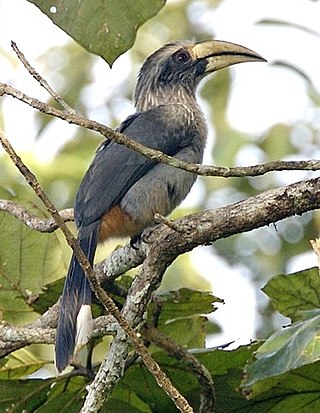
The Malabar gray hornbill is a hornbill endemic to the Western Ghats and associated hills of southern India. They have a large beak but lack the casque that is prominent in some other hornbill species. They are found mainly in dense forest and around rubber, arecanut or coffee plantations. They move around in pairs or small groups, feeding on figs and other forest fruits. Their loud cackling and laughing call makes them familiar to people living in the region.

Walden's hornbill locally called dulungan, also known as the Visayan wrinkled hornbill, rufous-headed hornbill or writhe-billed hornbill, is a critically endangered species of hornbill living in the rainforests on the islands of Negros and Panay in the Philippines. It is closely related to the writhed hornbill, but can be recognized by the yellow throat and ocular skin in the male, and the blue throat and ocular skin in the female. Its binomial name commemorates the Scottish ornithologist Viscount Walden.
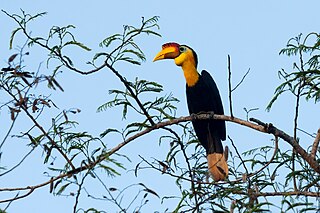
The wrinkled hornbill or Sunda wrinkled hornbill is a medium-large hornbill which is found in forest in the Thai-Malay Peninsula, Sumatra and Borneo.
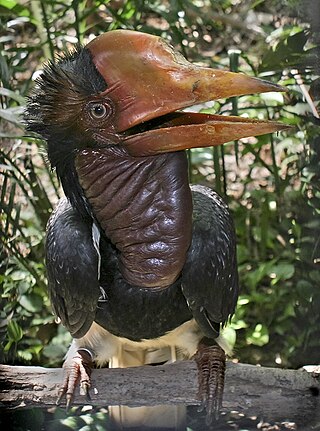
The helmeted hornbill is a very large bird in the hornbill family. It is found on the Malay Peninsula, Sumatra, Borneo, Thailand and Myanmar. The casque accounts for some 11% of its 3 kg weight. Unlike any other hornbill, the casque is almost solid, and is used in head-to-head combat among males. It is a belief among the Punan Bah that a large helmeted hornbill guards the river between life and death.

The great hornbill, also known as the concave-casqued hornbill, great Indian hornbill or great pied hornbill, is one of the larger members of the hornbill family. It occurs in the Indian subcontinent and Southeast Asia. It is predominantly frugivorous, but also preys on small mammals, reptiles and birds. It has been listed as Vulnerable on the IUCN Red List since 2018. It is known to have lived for nearly 50 years in captivity. Due to its large size and colour, it is important in many tribal cultures and rituals. The Government of Kerala declared it as the official Kerala state bird.
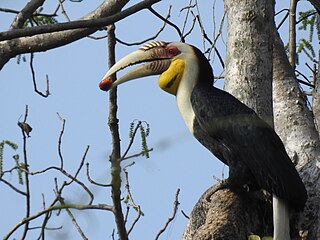
The wreathed hornbill is an Old World tropical bird of the hornbill family Bucerotidae, also called bar-pouched wreathed hornbill due to its distinctive blue-black band on its lower throat sac. It is named after its characteristic long, curved bill that develops ridges, or wreaths, on the casque of the upper mandible in adults. Males are black with a rufous crown, a white upper breast and face, and a yellow featherless throat. Females are uniformly black with a blue throat and are slightly smaller than males.

Blyth's hornbill, also known as the Papuan hornbill, is a large hornbill inhabiting the forest canopy in Wallacea and Melanesia. Its local name in Tok Pisin is kokomo.

Bucerotiformes is an order of birds that contains the hornbills, ground hornbills, hoopoes and wood hoopoes. These birds were previously classified as members of Coraciiformes. The clade is distributed in Africa, Asia, Europe and Melanesia.

Sumba hornbill, or known natively as Julang is a large bird belonging to the family of Bucerotidae, endemic and native to the Indonesian island of Sumba. The scientific name commemorates British colonial administrator and zoological collector Alfred Hart Everett.

The black-and-white-casqued hornbill also known as the grey-cheeked hornbill, is a large black and white hornbill. It has an oversized blackish bill with a large casque on top. The female is slightly smaller than the male and has a significantly smaller casque. It is a monogamous species, and pairs nest in suitable tree cavities. The female usually lays up to two eggs. The diet consists mainly of figs, fruits, insects and small animals found in the trees.
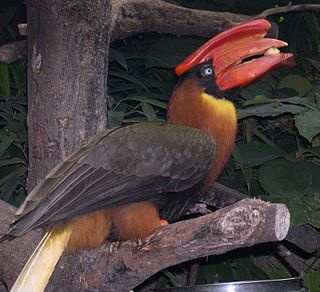
The rufous hornbill, also known as the Philippine hornbill and locally as kalaw, is a large species of hornbill endemic to the Philippines. They are referred by locals as the "clock-of-the-mountains" due to its large booming call which typically occur of every hour. It occurs in moist tropical lowland forest. They are now considered to be a threatened species and its reasons for decline being habitat destruction, hunting and poaching for the illegal pet trade.

The Sulawesi hornbill, also known as the Sulawesi tarictic hornbill, Temminck's hornbill or Sulawesi dwarf hornbill, is a relatively small, approximately 45 cm (18 in) long, black hornbill. The male has a yellow face and throat, and yellowish horn bill with black markings. The female has all-black plumage and a darker bill.

The Palawan hornbill is a large forest bird endemic to the Philippines. It is one of the 11 endemic hornbills in the country. It is only found in Palawan and nearby islands of Balabac, Busuanga, Calauit, Culion and Coron. It is locally known as 'talusi' in the language Cuyunon, It is threatened by habitat loss, hunting and trapping for the cage-bird trade.

The white-crowned hornbill, also known as the long-crested hornbill or white-crested hornbill, is a species of hornbill.

The Narcondam hornbill is a species of hornbill in the family Bucerotidae. It is endemic to the Indian island of Narcondam in the Andamans. Males and females have a distinct plumage. The Narcondam hornbill has the smallest home range out of all the species of Asian hornbills.
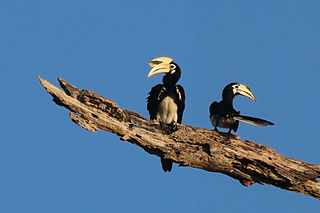
The oriental pied hornbill is an Indo-Malayan pied hornbill, a large canopy-dwelling bird belonging to the family Bucerotidae. Two other common names for this species are Sunda pied hornbill (convexus) and Malaysian pied hornbill.

The brown-cheeked hornbill is a species of hornbill in the family Bucerotidae. It is found in Ivory Coast, Ghana, Guinea, Liberia, Sierra Leone, and Togo. Its natural habitats are tropical and subtropical moist broadleaf forests, plantations, and secondary growth forests. It is threatened by habitat destruction, as timber is harvested and the forests become increasingly fragmented.

Rhyticeros is a genus of medium to large hornbills found in forests from Southeast Asia to the Solomons. They are sometimes included in the genus Aceros. On the other hand, most species generally placed in Aceros are sometimes moved to Rhyticeros, leaving Aceros as a monotypic genus only containing the rufous-necked hornbill.


























